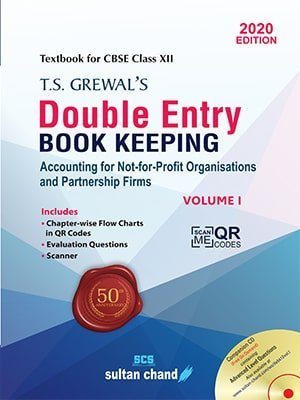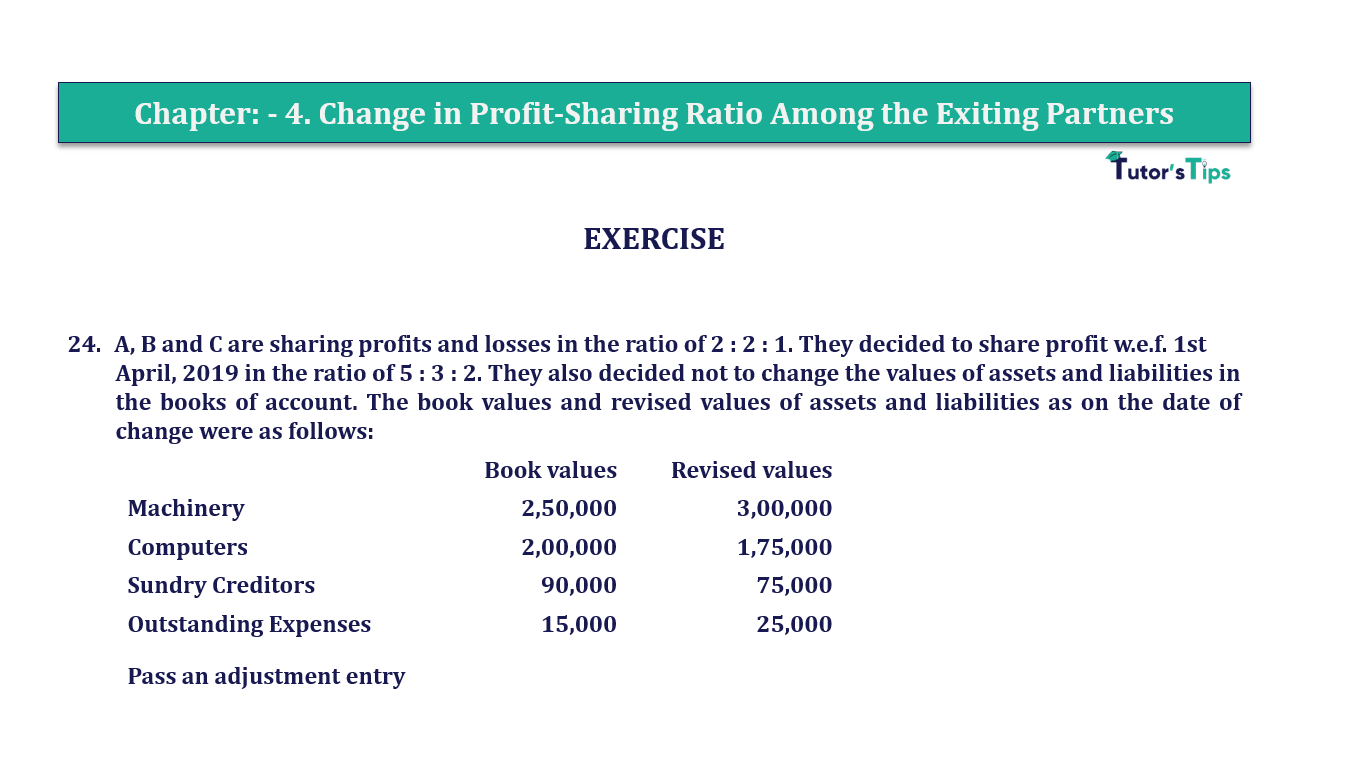Question 88 Chapter 2 of +2-A
88. Ankur, Bhavns and Disha are partners in a firm. On 1st April, 2017, the balance in their Capital Accounts stood at 14,00,000, 6,00,000 and 4,00,000 respectively. They shared profits in the proportion of 7 : 3 : 2 respectively. Partners are entitled to interest on capital @ 6% per annum and salary to Bhavna @ 50,000 p.a. and a commission of 3,000 per month to Disha as per the provisions of the partnership Deed. Bhavna’s share of profit excluding interest on capital is guaranteed at not less than 1,70,000 p.a. Disha’s share of profit Including interest on capital but excluding commission is guaranteed at not less than 1,50,000 p.a. Any deficiency arising on that account shall be met by Ankur. The profit of the firm for the year ended 31st March, 2018 amounted to 9,50,000.
Prepare Profit and Loss Appropriation Account for the year ended 31st March, 2018.
The solution of Question 88 Chapter 2 of +2-A:
| Balance Sheet (for the year ended 31st March 2019) |
|||||
| Liabilities |
Amount | Assets |
Amount | ||
| To Interest on Capital*1 | By Profit and Loss A/c | 9,50,000 | |||
| Ankur’s Capital A/c | 84,000 | ||||
| Bhavan’s Capital A/c | 36,000 | ||||
| Disha’s Capital A/c | 24,000 | 1,80,000 | |||
| To Salary to Bhavns | 50,000 | ||||
| To Commission to Disha | 3,000 ×4 | 36,000 | |||
| To Profit Transferred to *2 | |||||
| Ankur’s Capital A/c | 4,14,000 | ||||
| Bhavan’s Capital A/c | 1,80,000 | ||||
| Disha’s Capital A/c | 1,26,000 | 7,20,000 | |||
| 9,50,000 | 9,50,000 | ||||
Working Note: –
*1 Calculation of Actual Amount of Interest on Ankur’s, Bhavns’s, & Disha’s Capital
Interest on Capital = Opening Capital X Rate of Interest
| Interest on Ankur’s Capital | 14,00,000 | X | 6 |
| 100 |
Interest on Ankur’s Capital = 84,000/-
| Interest on Bhavns’s Capital | 6,00,000 | X | 6 |
| 100 |
Interest on Bhavns’s Capital = 36,000/-
| Interest on Disha’s Capital | 4,00,000 | X | 6 |
| 100 |
Interest on Disha’s Capital = 24,000/-
*2 Calculation of all Partners’ shares of Profits
Profit of the year = 7,20,000
Profit-sharing Ratio = 7 : 3 : 2
| Ankur’s Share of Profit | 7,20,000 | X | 7 |
| 12 |
Ankur’s Share of Profit = 4,20,000
| Bhavan’s Share of Profit | 7,20,000 | X | 3 |
| 12 |
Bhavan’s Share of Profit = 1,80,000
Advertisement-X
| Disha’s Share of Profit | 7,20,000 | X | 2 |
| 12 |
Disha’s Share of Profit = 1,20,000
Bhavan’s Minimum Guaranteed Profit = Rs 1,70,000 (excluding interest on capital)
Bhavan’s Actual Profit Share i.e. 1,80,000 is more than his Minimum Guaranteed Profit i.e. 1,70,000
So, there is no Deficiency in Bhavns’s Profit Share in this case
Disha’s Minimum Guaranteed Profit = Rs 1,50,000 (including interest on capital but excluding Commission)
Disha’s Minimum Guaranteed Profit (excluding interest on Capital) = 1,50,000 − 24,000 = Rs 1,26,000
Note: – Interest on Capital already credited from distributed profit, So that’s why it is a deduction from guaranteed profit.
Disha’s Actual Profit Share i.e. 1,20,000 is more than his Minimum Guaranteed Profit i.e. 1,26,000
Deficiency in Disha’s Profit Share = 1,26,000 − 1,20,000 = Rs 6,000
This deficiency of Rs 6,000 is to be borne by Ankur
Ankur’s New Profit Share = 4,20,000 – 6,000 = Rs 4,14,000
Also, Check out the solved question of previous Chapters: –
T.S. Grewal’s Double Entry Book Keeping +2 (Vol. I: Accounting for Not-for-Profit Organizations and Partnership Firms)
- Chapter No. 1 – Financial Statement of Not-For-Profit Organisations
- Chapter No. 2 – Accounting for Partnership Firms – Fundamentals
- Chapter No. 3 – Goodwill: Nature and Valuation
- Chapter No. 4 – Change in Profit-Sharing Ratio Among the Existing Partners
- Chapter No. 5 – Admission of a Partner
- Chapter No. 6 – Retirement/Death of a Partner
- Chapter No. 7 – Dissolution of a Partnership Firm
T.S. Grewal’s Double Entry Book Keeping (Vol. II: Accounting for Companies)
- Chapter No. 8 – Company Accounts – Accounting for Share Capital
- Chapter No. 9 – Company Accounts – Issue of Debentures
- Chapter No. 10 – Redemption of Debentures
T.S. Grewal’s Double Entry Book Keeping (Vol. II: Accounting for Companies)
- Chapter No. 1 – Financial Statements of a Company
- Chapter No. 2 – Financial Statement Analysis
- Chapter No. 3 – Tools of Financial Statement Analysis – Comparative Statements and Common- Size Statements
- Chapter No. 4 – Accounting Ratios
- Chapter No. 5 – Cash Flow Statement
Check out T.S. Grewal +2 Book 2020@ Official Website of Sultan Chand Publication








Leave a Reply